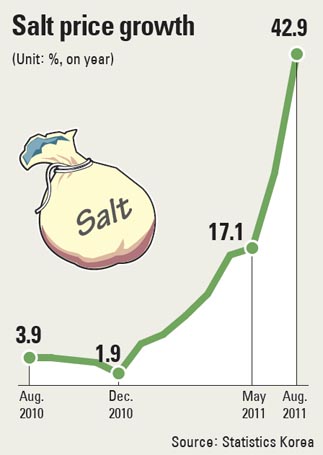Now even table salt costs too much

“Salt is a major ingredient in many Korean dishes along with soy sauce, and without it, any dish would taste bland,” she said. “I was surprised to see the price of such a basic essential soar significantly in just a few months.”
According to Statistics Korea yesterday, the price of salt rose 42.9 percent in August compared to the previous year. The increase is the highest in 30 years, after the salt price jumped 46.7 percent in September 1981.
The price for all kinds of salt - from bamboo salt to solar salt - has jumped since early this year, along with some other kitchen staples. The price of gochujang (red pepper paste), soybean sauce and doenjang (soybean paste) also jumped 18.7 percent, 21.7 percent and 18.2 percent respectively after the price of raw materials like beans went up.
“The rise in salt prices is due to the massive earthquake that broke out in Japan in March that damaged the nuclear power plants in Fukushima, leaking radioactive material into the sea,” said an official from Statistics Korea. “This drove local consumers to horde salt out of fear of contamination.”
The agency also blamed the wet weather this summer. According to industry officials, summer is when salt is produced in large quantities through natural drying processes, but this year the sunlight was reduced.
Housewives in the kitchen aren’t the only people being affected.
Major local salt manufacturers including Daesang and CJ CheilJedang are worried the government will pressure them to lower salt prices even if the price of crude salt keeps rising.
Korea’s consumer prices in August increased 5.3 percent from the previous year, remaining above the central bank’s target of 4 percent for eight consecutive months.
To tame inflation, the Fair Trade Commission has been enhancing its monitoring of prices of basic necessities, including kimchi and flour.
“The price of crude salt jumped almost 100 percent,” said an official from CJ CheilJedang with a sigh. The food manufacturer increased the price of its salt products by an average of 10 percent in July.
For example, the price of its 500-gram (18-ounce) solar salt product jumped 10 percent and now has a price tag of 1,850 won ($1.73). The last time the company increased its price was in April.
“The fluctuation in the price of salt is similar to that of many other agricultural goods,” the official said. “The price depends on the weather and the actual supply.”
By Lee Eun-joo [angie@joongang.co.kr]
한글 관련 기사 [중앙일보]
소금값이 ‘금값’
일 원전사고, 잦은 비에 천일염 10㎏ 1만2000원
올해 1월보다 2배 올라
소금은 절약의 상징이다. 반찬값을 아끼려고 소금에 절인 생선을 매달아 두고 쳐다보기만 했다는 ‘자린고비 이야기’에서 비롯됐다. 이젠 자린고비가 소금도 마음껏 못 쓰게 됐다. 소금값이 사상 최고 수준이다.
서울 송파구 가락농수산물도매시장에선 천일염 10㎏ 한 봉지 도매 가격이 1만2000원이다. 올 1월만 해도 6000원 남짓이던 것이 거의 두 배 가까이로 올랐다. 소금 가게 배은식(56) 사장은 “소금값 이렇게 비싸기는 처음”이라며 “음식점 사장이나 김치 공장에서 한숨을 쉬고 난리”라고 말했다. 통계도 그렇다. 통계청 8월 소비자 물가동향 조사에 따르면 지난달 소금 가격은 1년 전보다 42.9% 올랐다. 1981년 9월(46.7%) 이후 최고 상승률이다.
소금값 급등엔 일본 후쿠시마 원전 폭발 사고가 결정적인 영향을 미쳤다. “사고로 인해 한반도 인근 바다에서 나온 소금이 방사능에 오염될 수 있다”는 루머에 4월까지 소금 사재기 현상이 벌어진 것이다. 문제는 올 여름 집중 호우로 소금 생산량이 확 줄었다는 것이다. 배은식 사장은 “재고는 바닥이 난 상태인데 여름에 소금이 나질 않아 소금 창고들이 텅텅 비었다”고 말했다.
소금값은 당분간 강세를 보일 전망이다. 10월부터 내년 3월까지는 일조량이 부족해 소금이 생산되지 않는다.










with the Korea JoongAng Daily
To write comments, please log in to one of the accounts.
Standards Board Policy (0/250자)